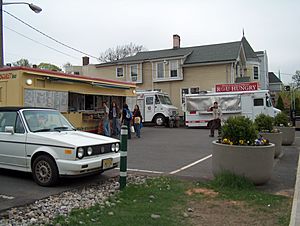Grease trucks facts for kids
Grease trucks were popular food trucks found at Rutgers University in New Brunswick, New Jersey. They were famous for making special "Fat Sandwiches." These sandwiches were huge sub rolls filled with many different foods. Imagine burgers, cheese, chicken fingers, and french fries all in one sandwich!
In 2004, Maxim Magazine named the "Fat Darrell" the best sandwich in the country. A student named Darrell Butler created this sandwich. The Grease trucks were a big part of campus life. Students loved to meet and hang out there. In 2005, Sports Illustrated On Campus even called them the top post-game activity. This was true even though they were far from the football stadium.
The Grease trucks moved from their long-time spot in August 2013. The plan was to move them to different places around the Rutgers campuses.
History of the Grease Trucks
Starting in the early 1980s, food trucks began parking along College Avenue in New Brunswick. Many were near Voorhees Mall, where many classrooms are. Students and visitors could quickly get hot, cheap meals. People started calling them "grease trucks" because they sold so many fried foods.
In the early 1990s, the university wanted to reduce noise and pollution. The trucks were blocking the view of Voorhees Mall. So, the trucks were asked to move from the street. Rutgers University gave them a special spot in a faculty parking lot. The university also provided electricity for the trucks. This meant they did not need noisy generators. Some trucks were open during the day, and others at night. The trucks would switch their spots each month. This made sure no one truck had a better location all the time.
At first, the trucks were open 24 hours a day. They became a popular spot for hungry customers after local bars closed. Over time, the university changed the closing time to 3 A.M. in 1996, and then to 2 A.M. in 1998.
In the early 2000s, some trucks joined together into one large food trailer. This was called "The Scarlet Shack." Over the years, new features were added. You could order by phone or online. The trucks also started taking credit cards and the Rutgers University food card.
In August 2013, the trucks moved from parking lot #8. They had been there for twenty years. A new building was going to be built in that spot. The university planned to move the trucks to different campuses. These included College Avenue, Busch, Livingston, and Douglass campuses.
Famous Fat Sandwiches and Other Foods
Grease trucks sold many typical grill foods. But their "fat" sandwiches were the most popular. These sandwiches were made with many different foods all mixed together. They could have burgers, french fries (inside the sandwich!), cheesesteak, mozzarella sticks, or chicken fingers. Other choices included pork rolls, marinara sauce, falafel, or even fried eggs.
These sandwiches may have started in the 1970s. A local restaurant sold a sandwich called the "Fat Cat." It had two cheeseburgers, french fries, lettuce, tomato, and sauces on a bun. In the 1980s, the "Fat Cat" became very popular at the grease trucks. Other early "Fat" sandwiches were the "Fat Moon," "Fat Koko," and "Fat Sam."
These cheap sandwiches included the "sides" right inside. They became more and more popular. The "Fat Cat" was the top seller until 1997. That year, a student named Darrell W. Butler created the "Fat Darrell." This sandwich had chicken fingers, mozzarella sticks, french fries, and marinara sauce. Darrell told USA Today he was broke and wanted all three foods. He asked the cook to put them all on bread. Soon, everyone wanted the "Fat Darrell."
Since then, many more "Fat Sandwich" types have been created. Customers often suggested new combinations. You can now find "Fat Sandwiches" in many places around New Brunswick. They are even popping up at other colleges across the country.
The Grease trucks were even featured on the TV show Man v. Food. In 2009, host Adam Richman tried the "Fat Sandwich Challenge." He tried to eat five fat sandwiches in 45 minutes. If he finished, he could name a new sandwich. He almost did it, eating four and a half sandwiches!
Grease trucks also offered many homemade Mediterranean foods. These included gyros, falafel, and hummus on pita bread. Some vendors came from Middle Eastern countries. They brought these healthier options to the trucks. You could also find eggs, soup, chips, cookies, and even homemade Rice Krispies Treats. Some trucks were open in the morning, selling breakfast items and bagels.



